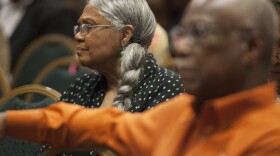UT Austin says it plans to rename certain campus spaces, add monuments that honor civil rights advocates and work harder to recruit Black students, faculty and staff.
Monday's announcement comes on the heels of demands from students and alumni that the university confront its racist past. But calls to change the school song, which has a racist history, won’t be met.
“Every action we take must support the people who make UT such a special place and must fulfill our mission to teach, learn and discover,” interim UT President Jay Hartzell said in a letter announcing the plan.
Last month, a group of Texas athletes, mainly football players, said they would not participate in functions beyond games and practices if a list of changes was not addressed. They asked for building name changes and the removal of statues that honored men who participated in the Confederacy or espoused racist beliefs.
To some, the list seemed new, but many have asked for similar changes through the years.
“In the late '60s and early '70s, we asked for the same thing — more intensive efforts toward the recruitment of more Black students, faculty and staff,” said Cloteal Davis Haynes, president of the Precursors, a group of UT alumni who were some of the first Black students to attend UT more than 40 years ago. “For the first time in a long time, I see significant movement toward addressing these very complicated issues.”
There is one big item on the athletes’ list that is not going away. The university is keeping its school song, “The Eyes of Texas,” but pledges to teach its origins and work to “reimagine” its future.
Though the song isn’t changing, UT says there will be changes within the athletic department. The field at Darrell K. Royal-Texas Memorial Stadium will be renamed in honor of Texas greats Earl Campbell and Ricky Williams. The field is currently named for the late attorney Joe Jamail. The university says it was the idea of the Jamail family to make the change.
A statue will also be placed outside the football stadium recognizing Julius Whittier, the first Black football player to letter at the school in 1970.
Additionally, the athletic department will allocate money to on-campus and off-campus programs to attract, retain and support Black students.
There will be changes to other parts of campus, as well, to honor UT's civil rights trailblazers and downplay its more suspect roots.
The school will rename Robert L. Moore Hall to the “Physics, Math and Astronomy Building.” It was named after a UT mathematics professor who was known to have racist views toward Black students.
"It's sort of a Rip Van Winkle time. People are awakening, after being asleep so many years, to see the injustices that have taken place."
The university will also shine a light on its integration struggle by honoring Heman Marion Sweatt. He successfully challenged UT President T.S. Painter in the U.S. Supreme Court to integrate the UT Law School in 1950. An entrance to T.S. Painter Hall on campus will be named in honor of Sweatt. A statue of him will be placed near the entrance and a space inside the building will be redesigned to display the story of Sweatt v. Painter.
UT will also honor its first class of Black undergraduate students, the Precursors, with a monument on the East Mall — 64 years after they first arrived on campus.
“It’s sort of a Rip Van Winkle time,” said Leon Holland, a member of the Precursors. “People are awakening, after being asleep so many years, to see the injustices that have taken place.”
Black students make up just 5.1% of UT’s population. While enrollment among Black undergraduate students at UT has increased 9% in the past five years, Hartzell says the school could have done better. More than 1,900 Black students were accepted to the university during that time but chose to go elsewhere.
This is where that fund from the athletics department comes into play. It will be invested into programs that make the university more attractive and able to retain students once they’re on campus. The school says there will also be programs to develop Black leaders and help prepare students for life after graduation, as well as a refreshed Diversity and Inclusion Action Plan overseen by Leonard Moore, the vice president for diversity and community engagement.
Holland and his fellow Precursors have been working for on-campus changes for years.
“We’re super excited to watch the progress that’s been made over the last decade for sure,” Holland said. "And just to see the more progressive and visionary ideas in trying to bring solutions and corrections to the injustices that we’ve experienced over the past to come to fruition is very exciting."
Some controversial names of buildings and campus features are not going away, for now. Among them are the Littlefield Fountain, Hogg Auditorium and the Belo Center for New Media. The university says it will educate visitors about the origins of the names and their context.
The timeline for the changes is not clear, but the university says there is a website offering information and updates as the improvements get underway.
Got a tip? Email Jimmy Maas at jmaas@kut.org. Follow him on Twitter @maasdinero.
If you found the reporting above valuable, please consider making a donation to support it. Your gift pays for everything you find on KUT.org. Thanks for donating today.






